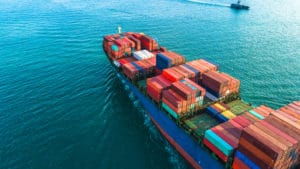
A new report shows that 400,000 seafarers stranded on ships continue to struggle amid the COVID-19 pandemic. When the COVID-19 pandemic began, ships around the world were forced to halt their routes. Cruise lines brought ships into ports, and cargo ships were left essentially stranded without the ability to enter ports or offload goods. This has raised numerous questions and concerns about maritime rights, options and safety among affected workers.
Now, cruise ships have mostly emptied and crew members have returned home. But what about workers onboard cargo ships? Sadly, their crisis continues without an end in sight. According to a new report, as many as 400,000 seafarers are still stranded on ships across the world. Many of these workers are continuing to work without relief in sight.
Thousands of Seafarers Stranded on Ships
With as many as 400,000 seafarers stranded on ships around the world, the United Nations is being called on to take action. Captain Hedi Marzougui has called on the UN General Assembly to take action and appeal to governments to let seafarers return home. Marzougui was in command of a vessel from December 2019 until May 2020. He says,
“Not knowing when or if we will be returning home brings a severe mental toll on my crew and myself. “I would encourage each and every one of you to think of how you would feel, if you had to work every day, for 12 hours, with no weekends, without seeing your loved ones, and trapped at sea. Now add that you have to do that with no idea of when you will be repatriated.”
Marzougui’s experience is just one of thousands of similar stories. When COVID-19 travel restrictions took effect, many seafarers saw their contracts extended by months, or almost indefinitely. Despite pleas for governments to categorize seafarers as “essential workers” so they would be allowed to travel, hundreds of thousands of seafarers remain at sea. These workers have no indication of when they may be able to go home.
Some seafarers have been on ships for 17 months without a break. The Maritime Labour Convention (MLC) mandates a maximum of 11 months for seafarer contracts.
Not only are 400,000 seafarers still stranded at sea, but there are almost as many seafarers on land who are now unable to join ships and resume work. For these seafarers, their roles are occupied by the seafarers currently stranded well beyond their contract end dates. This is causing a great deal of hardship for seafarers across the maritime industry.
Seafarer Crisis Threatens Ship Safety Standards
Secretary-General of the International Maritime Organization (IMO), Kitack Lim, says that the current seafarer crisis threatens ship safety standards. He says that,
“Overly fatigued and mentally exhausted seafarers are being asked to continue to operate ships. On more than 60,000 cargo ships which continue to deliver vital goods, foods and medicines, ship safety is hanging in the balance, just as seafarers’ lives are being made impossible. The safety of navigation is in peril.”
Again, the Secretary-General is calling for action. He reminds officials that we all depend on seafarers and the work they do to deliver goods and provide services across the world. He also says that seafarers should not be collateral victims to the pandemic.
Along with the IMO and MLC, CEO’s of 30 companies participating in the Consumer Goods Forum have asked governments to designate seafarers as essential, or “key” workers. These companies are raising concerns about human rights with some saying the current crisis is a “modern form of force labour.”
Governments are being asked to do the following:
- Designate seafarers as essential or key workers
- Ensure safe crew changes onboard ships
- Implement protocols allowing seafarers to repatriate
- Implement protocols allowing seafarers to join ships for duty
Shipping officials are calling on governments to end the crisis quickly, since a continuance will only increase the number of seafarers affected. Without coordinated government efforts, seafarer health and safety will continue to decline. Furthermore, economies around the world may continue to feel the impact of shipping interruptions.
Maritime Industry Struggles due to COVID-19
In general, maritime workers continue to struggle amid COVID-19. The struggles of the cruise line industry are clear. As of August 2020, some 12,000 cruise ship crew members were still stranded on cruise ships. Coronavirus on cruise ships has been a hot topic for most of the year.
The original No Sail Order went into effect in March, and has now been extended through the end of October. That means that maritime workers in various occupations will continue to struggle as they adjust to a very new sense of normal. Many workers are stranded on ships, while others are unable to secure work they were counting on. And yet others are facing the threat of the COVID-19 pandemic head-on.
Sources:
https://container-mag.com/2020/09/28/crew-change-crisis-deepens-with-400000-seafarers-stuck-at-sea/